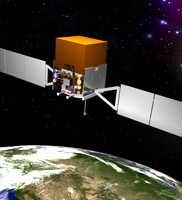

Tuesday - October 10, 2006
SLAC Today is
available online at:
http://today.slac.stanford.edu
In this issue:
Particle Physics and the Press
Safety Today: Stress: It Doesn't do a Body Good
Registration for the First GLAST International Science Symposium
Safety Second
Students Contribute to ILC Damping Ring Studies at Cornell University
 |
 |
|
Tuesday - October 10, 2006 |
Particle Physics and the Press
The InterAction Collaboration of particle-physics communicators in Hamburg, Germany, in October 2006. (Image courtesy KEK. Click image for larger version.) The media have a central role in telling the story of research in particle physics. We need to put aside our differences and keep our eyes on the big picture if we are to make the most of this vast resource, say members of the InterAction collaboration. These are exciting times for particle physics, and the world's press are taking notice. As the Large Hadron Collider prepares to begin operations, as the International Linear Collider becomes an ever more clearly defined project, as programs for neutrino physics and astrophysics flourish, and most of all as long-awaited discoveries reveal the secrets of the universe, our friends in the media will share the adventure. Their stories and articles, TV programs, blogs and podcasts will inform and inspire others with the spirit of excitement that particle physicists are feeling at the start of the 21st century. Read more... |
||
|
|
||

Stress: It Doesn't
|
Registration for the First GLAST International Science Symposium
The GLAST Spacecraft. (Image courtesy of NASA.)
The first international science Symposium focused on the new scientific investigations enabled by the Gamma-ray Large Area Space Telescope (GLAST) mission will be held at Stanford University on February 5-8, 2007. The conference will be held at the Frances Arrilliga Alumni Center on the Stanford campus. GLAST is a mission to discover and study cosmic gamma-ray sources in the energy range 20 MeV to >300 GeV with the Large Area Telescope (LAT), with supporting measurements for gamma-ray bursts from 10 keV to 25 MeV with the GLAST Burst Monitor (GBM). With its launch in Fall 2007, GLAST will open a new and important window on a wide variety of high-energy phenomena, including black holes and active galactic nuclei; gamma-ray bursts; pulsars; the origin of cosmic rays and their relation to supernova remnants; probes of the optical-UV EBL; new source classes; solar physics; and searches for signals of hypothetical new phenomena such as particle dark matter annihilations, extra dimensions, Lorentz invariance violation, and other relics from the Big Bang. The first Guest Investigator Cycle for the scientific community will start in 2007, with proposals due soon after the Symposium. Read more... Safety SecondsIn yesterday's edition, I asked for some simple ways to enhance the safety of familiar, seemingly low risk activities. One answer: Ask yourself if you are suitably prepared for the worst thing that could happen while you are doing simple daily activities—like walking around the site or moving objects. |
Events (see all | submit)
Access (see all)
Announcements
|
| | ||
|
|
||
 <%
Response.AddHeader "Last-modified", getArticleDate()
'Response.AddHeader "Last-modified","Mon, 01 Sep 1997 01:03:33 GMT"
'Monday, December 06, 2010
%>
<%
Response.AddHeader "Last-modified", getArticleDate()
'Response.AddHeader "Last-modified","Mon, 01 Sep 1997 01:03:33 GMT"
'Monday, December 06, 2010
%>View online at http://today.slac.stanford.edu//. |
||